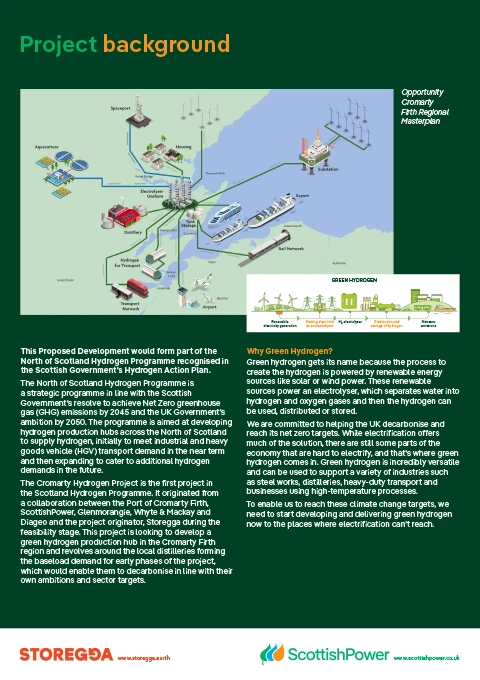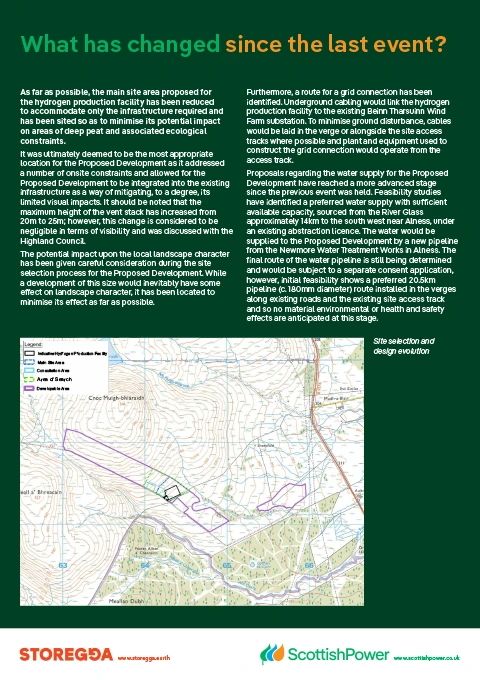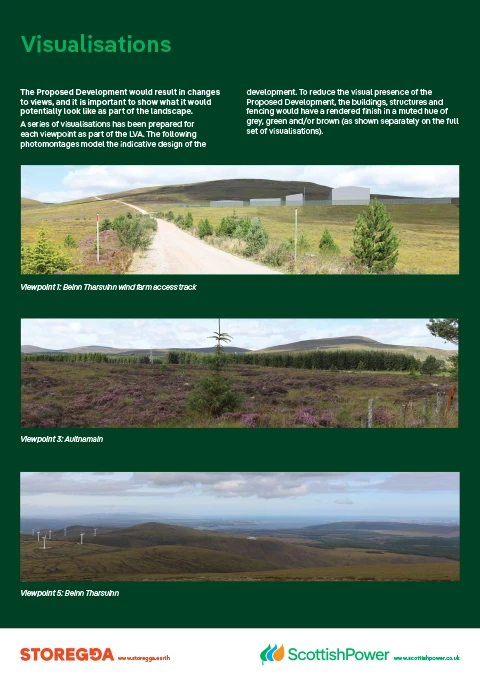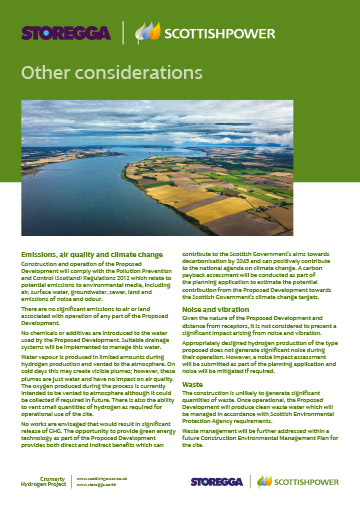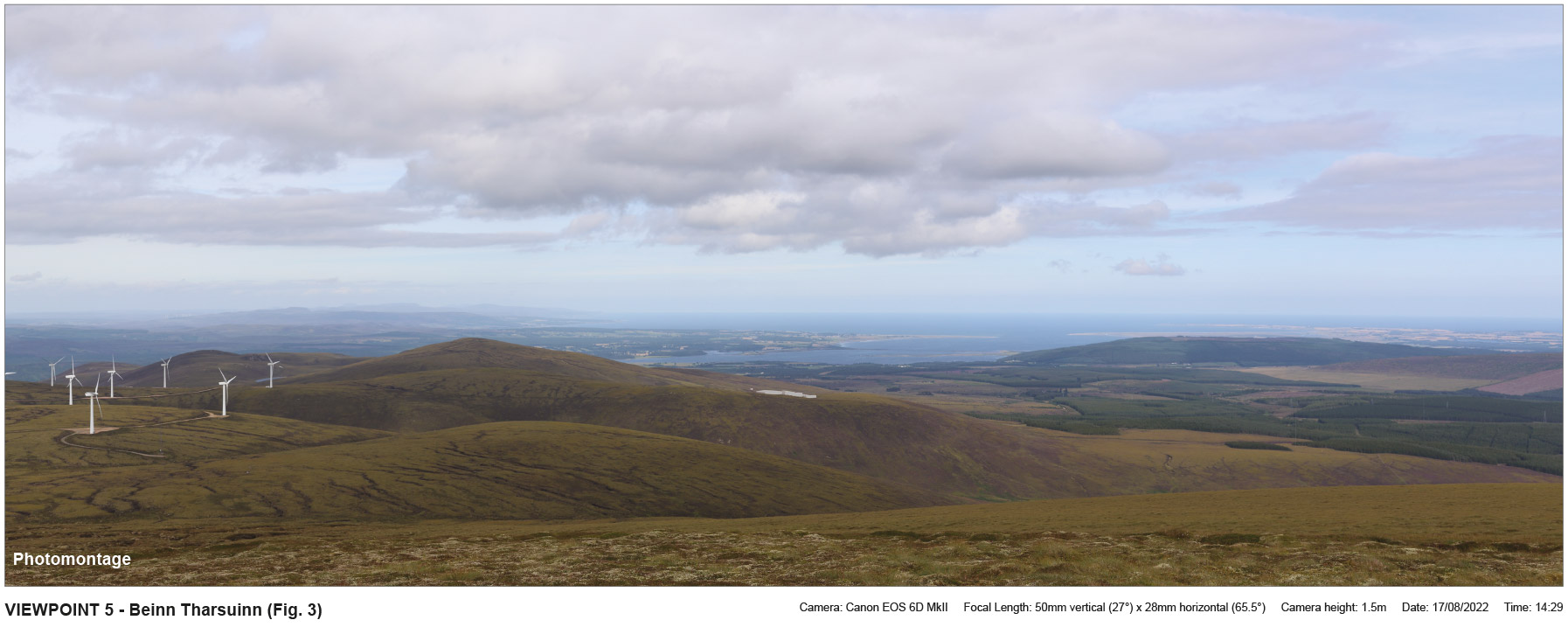Cromarty Hydrogen Project-23
Location
The Cromarty Hydrogen Project would be located on land to the east of the Beinn Tharsuinn Windfarm, approximately 12 km north of Alness.

Location plan
Current stage
ScottishPower, on behalf of the Cromarty Hydrogen Project, has submitted a planning application under Section 32 of the Town and Country Planning (Scotland) Act 1997 for the proposed construction and operation of an electrolyser plant and ancillary infrastructure (the ‘Proposed Development’). ScottishPower is undertaking this project with their joint development partners Storegga.
Project background
This Proposed Development would form part of the North of Scotland Hydrogen Programme recognised in the Scottish Government’s Hydrogen Action Plan1 The North of Scotland Hydrogen Programme is a strategic programme in line with the Scottish Government’s resolve to achieve Net Zero greenhouse gas (GHG) emissions by 2045 and the UK Government’s ambition by 2050. The programme is aimed at developing hydrogen production hubs across the North of Scotland to supply hydrogen, initially to meet industrial and heavy goods vehicle (HGV) transport demand in the near term and then expand to cater to additional hydrogen demands in the future.
The Cromarty Hydrogen Project is the first project in the Scotland Hydrogen Programme. It originated from a collaboration between the Port of Cromarty Firth, ScottishPower, Glenmorangie, Whyte & Mackay and Diageo and the project originator, Storegga during the feasibility stage. This project is looking to develop a green hydrogen production hub in the Cromarty Firth region and revolves around the local distilleries forming the baseload demand for early phases of the project, which would enable them to decarbonise in line with their own ambitions and sector targets.
Project History
Feasibility studies were undertaken in 2021 by the development partners to identify this area for development. Environmental surveys of the site and surrounding area were undertaken between Autumn 2021 and Summer 2023. Baseline data collected from these surveys and subsequent assessments have informed site selection and design evolution from a larger developable area.
Pre-application consultation with the Highland Council has been ongoing since Autumn 2021, including a formal pre-application advice meeting, which was held on 8 June 2022 for the Highland council and other key consultees to provide early indications of their view of the scheme.
Public consultation events were held in September and November 2022 at key stages in the development process to inform the public and other interested parties of emerging and final proposals and baseline environmental conditions and potential impacts. Comment and feedback on the Proposed Development was invited.
A request for a Screening Opinion from THC under The Town and Country Planning (Environmental Impact Assessment) Regulations 2017 was made in December 2022. A Screening Opinion was received in February 2023, which confirmed that an EIA (Environmental Impact Assessment) is not required for the Proposed Development.
The Applicant has undertaken a suite of environmental appraisals based on the characteristics of the final indicative design and of the existing environment. These form part of the planning application supporting information, in addition to a Supporting Statement, Pre-application Consultation Report, Design and Access Statement, Transport Statement and Planning Statement.
Consultation
Throughout the process the development partners have ensured that local communities and stakeholders have been given the opportunity to provide feedback and are kept informed.
During the pre-application stage, three hybrid (in-person and online) public events were held during September and November of 2022. The material from those events is available here.
On the 20 and 21 of November we held two in-person events at Ardross Community Hall, Ardross and Edderton Village Hall, Edderton. The material from those events is available below:
If you wish to make a formal representation, this should be made direct to the Highland Council.
Early consultation
Welcome to the Cromarty Hydrogen Project Public Information Event. The event will detail ScottishPower Energy Retail and Storegga’s proposal to construct and operate an electrolyser plant on land directly to the east of the Beinn Tharsuinn Windfarm, approximately 12 km north of Alness. This electrolyser plant will be powered by 100% renewable energy to produce green hydrogen by splitting water into hydrogen and oxygen using electrolysis.

Project Description
Although the proposed design of the development is yet to be finalised, based on its initial layout the facility could consist of several buildings up to approximately 15m in height. The extent of the Proposed Development would likely measure approximately 250m x 100m.
Access to the site would come off the existing Beinn Tharsuinn Windfarm access track which runs from the B9716 Struie road, approximately 2 km to the east.
The facility would have a maximum output of up to 50 megawatt (MW) although this is likely to be limited in the first instance to around 30MW and be able to produce up to 20,000 kg of green hydrogen per day. The facility will have multiple electrolysers feeding on-site low pressure storage containers. The hydrogen will then be compressed onto tube trailers for transportation off-site to customers. It is our intention to use low or zero carbon fuels for the hydrogen transport vehicles wherever possible.
The following banners contain further information on the proposal as well as visualisations to help give an impression of what the Proposed Development could look like from different viewpoints in the area.
Frequently asked questions
- Will this affect public access along the existing Beinn Tharsuinn Windfarm access?
During construction there may be some access restrictions in the immediate vicinity of construction site, but there will be careful traffic management to ensure unimpeded access along Beinn Tharsuinn access. During operation, the existing access track access track is suitable for HGV use in regard to size of passing places and running surface so HGVs will be able to safely pass non-motorised users.
- Why have you chosen this location?
Hydrogen development in the Cromarty Firth Area is advantageous for multiple reasons. Production can be coupled with multiple end-uses and it is in an area where the grid network cannot absorb all wind generation. Proposed works to improve grid capacity are not likely to be completed in time to meet the Scottish Governments Climate Change and hydrogen production 2030 targets.
The Proposed Development is considered decentralised production, which means production of green hydrogen that is co-located to the generation of renewable energy as the source for electrolysis. Utilising power from Beinn Tharsuinn Wind Farm in the first instance will provide an initial low cost source of energy (sourcing electricity is typically the largest component of hydrogen production costs), which will be supplemented by green energy supplied through the existing grid connection as required, to feed hydrogen production. De-centralised production creates opportunities for hydrogen production at a dispersed and relatively small scale to support local decarbonisation and/or to take advantage of specific instances where there are high levels of renewable energy that cannot be exported to the grid due to constraint. It can be an early action and enabler in developing capacity, knowledge and confidence in Scotland’s hydrogen economy by providing ‘scale-up’ projects that demonstrate deliverability and utility of hydrogen.
A De-centralised Green Hydrogen Production Site Identification and Opportunities Study was conducted for Scottish Enterprise, South of Scotland Enterprise & Highlands & Islands Enterprise, which conducted an analysis of constrained renewable energy generation locations to create a ‘shortlist’ of sites that could be suitable for decentralised hydrogen production. A cluster was identified in Cromarty and Ross-Shire.
The siting, layout and design of the Proposed Development have been refined and finalised and have taken potential environmental effects into consideration in order to seek to mitigate by design predicted adverse effects as far as reasonably practicable. The resultant proposal balances the environmental and technical constraints, whilst producing an economically viable project overall.
- Why distilleries?
In the context of the focus on co-located projects, Cromarty Hydrogen identified several distilling sites in the region suitable for the offtake of hydrogen. The Hydrogen for Scottish Distilleries report for Scottish Enterprise (Ricardo, 2023) outlines the need for the Proposed Development in order to help local distilleries decarbonise. The Scotch Whisky Association (SWA) has committed to reaching Net Zero emissions from its operations by 2040. Green hydrogen is one potential solution for industrial decarbonisation, particularly in processes that require high temperatures and are difficult and costly to electrify. Distilleries form a significant portion of Scotland’s industry and face many challenges to decarbonise. Heating is responsible for the majority of a distillery’s energy demand and carbon emissions. To achieve Net Zero targets, a combination of energy efficiency measures and switching to sustainable fuels is required. The ‘Scotch Whisky Pathway to Net Zero’ report produced by Ricardo for the SWA in 2020 modelled seven scenarios to explore the Net Zero gap and identify viable pathways to 2045. Three of the seven modelled pathways included the use of hydrogen. Moreover, these same pathways were the only ones of the seven that presented a route to achieving Net Zero, thus exemplifying the pivotal role hydrogen will play in the decarbonisation of the distilling industry.
- What happens next?
A planning application has been submitted to the Highland Council who will consult with relevant stakeholders as part of their determination process. As part of the determination process the Highland Council will be able to receive representations from members of the local community and community councils that could be affected by the proposals. Typically, once the planning application has been validated the Highland Council will issue a public notice from which point there will be a period of 21 days in which representations can be submitted. The overall determination process could take several months and it is not expected that a decision will be made until later in 2024.
In addition to planning permission, the applicant will also require other consents, permits and licenses relating to the environmental and health and safety aspects of the Proposed Development.
As stated on the boards, the control of major accident hazards involving dangerous substances, to prevent major accidents and limit the consequences of such accidents, is primarily managed through the Control of Major Accident Hazards Regulations 2015 and The Town and Country Planning (Hazardous Substances) (Scotland) Regulations 2015. A hazardous substances consent application will be submitted, if required, separately to the planning application. The COMAH Regulations deal with on-site safety measures, requirements for the preparation of on-site safety management systems and emergency plans and the inspection of sites. In Scotland the COMAH Regulations are enforced by a competent authority comprising the Health and Safety Executive (HSE) and the Scottish Environment Protection Agency acting jointly. The Proposed Development would require to be constructed and operated in accordance with the regulations.
Operators undertaking activities regulated by the Pollution Prevention and Control Regulations are required to have a permit to operate in advance of activities commencing. The Pollution Prevention and Control permitting regime regulates a range of activities and processes that present relatively significant environmental effects and impacts. This ensures that emissions to environmental media (including air, surface water, groundwater, sewer, land and emissions of noise and odour) together with resource efficiency (including raw materials, energy and sustainable approaches to waste management and environmental management) are considered together when determining the conditions to be included in the permit that regulates these operations.
Similar considerations apply to certain activities associated with the water environment which are regulated by the Water Environment (Controlled Activities) (Scotland) Regulations 2011. Operators undertaking certain controlled activities in the water environment may require a licence under the 2011 Regulations.
Depending on the nature of the regulated activities undertaken, an operator will be required to submit the relevant permit or licence application to the Scottish Environment Protection Agency (SEPA). The relevant permissions will be applied for in due course.
- How will the hydrogen fuel be transported if the roads are closed because of winter conditions?
We recognise that ScottishPower and Storegga will have to manage this operational requirement. It is not our intention to store large volumes of hydrogen on site and the principle will be that we will transport what we create. There will inevitably be some storage volume for operational use, this is unavoidable. When the B9176 is closed and tube trailers are unable to access the site then ScottishPower and Storegga will have the ability to stop operations to prevent backlog of hydrogen production.
- What other potential environmental effects have you considered?
In addition to the potential environmental effects covered on the boards, potential effects on air quality, and archaeology and cultural heritage where scoped out of detailed appraisal in discussion with the Highland Council.
The potential for light pollution from site has been considered. Permanent night-time lighting is proposed along the perimeter of the site and at the entrance, and where possible, directed downward and carefully designed not to contribute to light pollution.
- Is there plans for the project to be extended to other sites?
Although the concept is at planning and design stage, hydrogen-related development in the UK has strong policy support at all levels, notably the Scottish Government’s Hydrogen Action Plan and the North of Scotland Hydrogen Programme (as described in the Supporting Statement) and the Planning Statement which accompany this application.
Our focus is on the successful development of the Cromarty Hydrogen Project as described in the planning application however it is possible that opportunities for other developments in this sector, particularly around proposed hydrogen clusters, may well come forward as technology matures and the market gathers momentum.
In 2021, ScottishPower and Storegga completed the Feasibility Study for Cromarty Hydrogen which outlined a four phase approach to developing a regional hydrogen cluster involving up to 300MW of electrolysis across a minimum of two sites. Originally this included an expansion of hydrogen production at Beinn Tharsuinn but this will no longer happen with the current proposal being the limit of hydrogen production capacity envisaged at the wind farm.
Cromarty Hydrogen has shortlisted several locations across the Cromarty & Inverness Green Freeport region for the expansion to meet the envisaged hydrogen demand for the region and wider Highlands.
Other considerations
Emissions, Air Quality and Climate Change
Construction and operation of the Proposed Development will comply with the Pollution Prevention and Control (Scotland) Regulations 2012 which relate to potential emissions to environmental media, including air, surface water, groundwater, sewer, land and emissions of noise and odour.
There are no significant emissions to air or land associated with operation of any part of the Proposed Development.
No chemicals or additives are introduced to the water used by the Proposed Development. Suitable drainage systems will be implemented to manage this water.
Water vapour is produced in limited amounts during hydrogen production and vented to the atmosphere. On cold days this may create visible plumes; however, these plumes are just water and have no impact on air quality. The oxygen produced during the process is currently intended to be vented to atmosphere although it could be collected if required in future. There is also the ability to vent small quantities of hydrogen as required for operational use of the site.
No works are envisaged that would result in significant release of GHG. The opportunity to provide green energy technology as part of the Proposed Development provides both direct and indirect benefits which can contribute to the Scottish Government’s aims towards decarbonisation by 2045 and can positively contribute to the national agenda on climate change. A carbon payback assessment will be conducted as part of the planning application to estimate the potential contribution from the Proposed Development towards the Scottish Government’s climate change targets.
Noise and Vibration
Given the nature of the Proposed Development and distance from receptors, it is not considered to present a significant impact arising from noise and vibration.
Appropriately designed hydrogen production of the type proposed does not generate significant noise during their operation. However, a noise impact assessment will be submitted as part of the planning application and noise will be mitigated if required.
Waste
The construction is unlikely to generate significant quantities of waste. Once operational, the Proposed Development will produce clean waste water which will be managed in accordance with Scottish Environmental Protection Agency requirements.
Waste management will be further addressed within a future Construction Environmental Management Plan for the site.
Archaeology and Cultural Heritage
We have…
Undertaken a desk-based review of heritage constraints data held by THC Historic Environment Record, National Record of the Historic Environment, designated heritage assets maintained by Historic Environment Scotland, and previous survey data from the Beinn Tharsuinn Windfarm Environmental Statement Addendum for Revised Access.
We have also undertaken an initial assessment of potential effects as a result of the Proposed Development
We found…
There are no known heritage assets within the site, or immediate vicinity. Historical mapping and previous survey work undertaken for the development and construction of Beinn Tharsuinn Windfarm indicate there is negligible potential for unknown archaeological remains within the site or immediate vicinity. No direct or indirect impacts that may affect the preservation of a heritage asset are anticipated.
The site does not currently contribute to the significance of any heritage assets and the nature and scale of the Proposed Development is unlikely to challenge the prominence of any monuments. Therefore, potential impacts on the setting of heritage assets are unlikely.
What we propose to do…
Based on our work undertaken to date we are proposing that no further assessments are required.

Ecology and Ornithology
Understanding the potential for a development to impact on habitats, birds and other species is an important part of scheme design.
We have…
Undertaken an initial desk study and Extended Phase 1 Habitat Survey to establish baseline ecological conditions.
We found…
The site is chiefly dominated by marshy grassland with areas of blanket bog and dry and wet heath adjacent to it, which are locally relatively common. During the survey, no evidence of protected species was identified. Furthermore, the site was considered as having only limited value for protected species, with no ponds, hedgerows and trees onsite.
The site is considered unsuitable for scarce and protected bird species, such as waders or raptors. The relatively small size of the site, and proximity to the existing wind farm access road further indicates its potential for impacts on birds is limited.

What we propose to do…
An ecological assessment will be submitted as part of the planning application. This will identify important ecological features, characterise potential impacts, outline mitigation measures and assess residual effects. We will also identify opportunities for ecological enhancement in the area, which will be detailed in a habitat management plan.
Hydrology, Hydrogeology, Geology and Soils
We have…
Undertaken a preliminary peat depth survey.
We found…
Our understanding of the ground conditions and surface water network has informed the choice of site location. The choice of site location has sought to avoid the areas of deepest peat and potential ground water dependant terrestrial ecosystems (GWDTE). The site maintains appropriate set back distances from all natural watercourses.

What we propose to do…
Areas of previously disturbed ground will be utilised as far as possible, including for all connecting facility cables to follow existing access tracks.
Where peat and GWDTE cannot be avoided, location-specific mitigation measures will be set out to minimise potential impacts. This will include a peat management plan. Water management to control surface runoff will be proposed, including water control measures and sustainable drainage systems.
We will include the following assessments as part of the planning application:
- Drainage impact assessment;
- Flood risk assessment; and
- GWDTE.
Visualisations
A series of visualisations will be prepared for each viewpoint as part of the LVA. These will be a mix of photomontages and wireline representations of the Proposed Development. The following indicative photomontages have been prepared for this public consultation event. The model of the development is based on initial design work and only shows massing of the different buildings and components. A more detailed model will be prepared for the full planning application.
The viewpoints and photography form part of the information used to inform a systematic and objective assessment of the potential impacts of the Proposed Development on landscape, views and visual amenity of the area surrounding the site.
The potential to mitigate adverse landscape and visual effects will be explored through careful siting and design, ensuring that the infrastructure’s materials and finishes are well specified to help blend into the hillside (additional photomontages have been prepared to show mitigating effect of using a green finish to match development with surrounding landscape), with perimeter fencing and lighting being kept to a minimum.
Landscape and Visual Assessment (LVA)
The Proposed Development will result in changes to views and it is important to show what it would potentially look like as part of the landscape. It is also important that a transparent and objective assessment of potential changes to landscape and views resulting from the Proposed Development is made using established guidance and procedures.
An LVA is being undertaken in line with THC requirements and in accordance with guidance from NatureScot and the Landscape Institute. The LVA examines effects on both the landscape and the views and visual amenity experienced by people living and visiting the area. The potential to mitigate adverse landscape and visual effects will be explored through careful siting and design, ensuring that the infrastructure’s materials and finishes are well specified to help blend into the hillside (additional photomontages have been prepared to show mitigating effect of using a green finish to match development with surrounding landscape), with perimeter fencing and lighting being kept to a minimum.
The LVA will use a series of viewpoints representative of views experienced from publicly accessible locations in the area. The following viewpoints have been agreed with THC and are shown on the Zone of Theoretical Visibility figure:
- VP01 – Beinn Tharsuinn wind farm access track
- VP02 – B9176
- VP03 – Aultnamain
- VP04 – Unclassified road west of Balleigh
- VP05 – Beinn Tharsuinn
- VP06 – Unclassified road at Rhannich
Zone of Theoretical Visibility
The figure below shows the theoretical visibility of the Proposed Development without the screening effect of the woodland and settlement. Taking account of the relatively small size and scale of the Proposed Development and the screening provided by the surrounding landscape and vegetation, the Proposed Development is relatively well contained. Potential views of the Proposed Development will be largely limited to those experienced at close proximity and views from elevated high points to the north, west and at longer distance to the south-west from the summit of Beinn Tharsuinn.
Key considerations
Traffic and transport
Access to the site would come off the existing Beinn Tharsuinn Windfarm access track which runs from the B9716 Struie road, approximately 2 km to the east.
Traffic associated with construction of the facility would predominantly comprise deliveries of construction plant, equipment, and materials for the construction of the development compound, foundations, hardstanding, internal access roads and buildings. The impact of construction traffic would be temporary and would be managed through standard good site practices and the provision of a Construction Traffic Management Plan.
During operation, hydrogen produced will be collected by tube trailer with 4 filling bays provided for this purpose. During the design phase the project will look to optimise the filling to minimise the number of trailers needed to move the hydrogen from the site. The developers are working with industry partners on next-generation tube trailers which would require fewer HGV movements.
A standalone Transport Statement will be submitted with the planning application, to include details of construction and operation HGV movements along with an appraisal of the permanent site access arrangements and potential transport impacts of the proposal. The potential impacts will be assessed with reference to the Council’s Guidance on Transport Assessment Methodology for Renewable Energy Proposals.
Health and Safety
There are no significant risks to health identified in the context of the construction or operation of the Proposed Development.
Hydrogen facilities, like all facilities handling industrial gases, have inherent risks associated with them. However, these risks will be factored into the design of equipment and measures will be put in place to mitigate these risks.
Hydrogen is a ‘named substance’ under the Control of Major Accident Hazard (COMAH) regulations 2015 and the Proposed Development will require to be constructed and operated in accordance with the regulations. This includes a requirement to demonstrate an inherently safe design and to show that appropriate design safety principles have been adopted and embedded throughout the planning and design stages.
As a COMAH site the Proposed Development will require a hazardous substance consent. This consent is a planning control that enable the relevant authorities to consider whether the presence of a significant quantity of a hazardous substance is appropriate having regard to the risk to the community.
In addition the Proposed Development would be subject to further safety regulations including the Health and Safety at Work Act 1974 and Construction (Design and Management) Regulations 2015.
The Development is not in a location which is susceptible to natural disasters.


